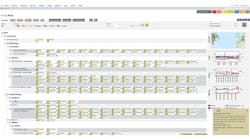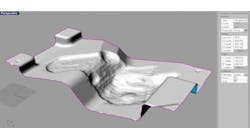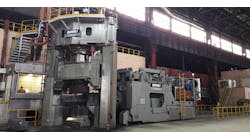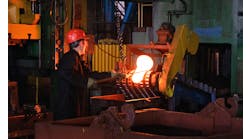Latest from Simulation/IT
New Article
Industrial IT Monitoring
Die Cost Estimating
Next-Level HMIs for Forging
Software for Non-Circular Grinding
Production Efficiency Software
AR Connects Workers to Experts
Danieli Integrated Forging Complex
Can ERP Really Guide You to Better Decision-Making?
Machines becoming self-aware and taking over the world is one of the most popular science fiction plots of movies and books. Whether it is Hal, the omniscient computer on Stanley Kubrick’s 2001: A Space Odyssey or IBM’s super computer Watson, which competed (and won) on Jeopardy!, the prospect of thinking machines has intrigued us for decades. For professionals in the IT industry, the imminent role of artificial intelligence and automated intelligence on business processes is more fact than fiction. Understanding how modern enterprise resource planning (ERP) can be used to guide decision-making is the first step in the evolution of Big Data into Big Decisions for manufacturing.
Artificial intelligence is not part of the solutions standardly employed by manufacturers now, but modern ERP solutions go a long way to guide and shape the way users make decisions. These capabilities, however, often are underutilized by CIOs and COOs who are involved choosing appropriate decision-making models and creating the guidelines the software should use when making predictions and recommendations. Humans must distill and reference the complex sets of data, conditions and historical examples typically used in decision-making.
Informed decision-making has long been one benefit of end-to-end solutions. By providing enterprise-wide visibility, users can be confident they are making operational decisions based on accurate data — and the same data that all personnel reference, no matter where in the organizational chart they sit.
Recently, increasing the speed of decision-making has become the greater priority, with the emphasis turning to real-time data and transaction-based analysis, rather than historical reports. Users need the ability to drill into series of related events behind the analytics to get the full range of influencing issues before making a decision.
This isn’t always easy to do. As the Deloitte University Press noted recently in their Reengineering Business Intelligence report, “…93% of C-level executives indicated that their organizations are losing revenue opportunities by not fully taking advantage of the data they collect. Nearly all of the respondents say their organizations need to improve information optimization soon. Nearly half feel that the ability to translate information into actionable insight is the most important area on which to focus.”
Today, manufacturers have additional reasons for needing guided decision-making tools. As baby boomers retire and take with them years of experiences and tribal knowledge, manufacturers struggle to deal with skill gaps and recruit right-skilled younger workers. This means under-experienced, under-skilled personnel often are in decision-making positions. Fortunately, these millennial-age workers also are comfortable turning to technology to assist their decision-making. Modern ERP solutions rise to the challenge, providing the tools users need now, whether it’s busy C-level executives or new recruits assigned to monitor inventory levels.
Deloitte reported that many manufacturers are taking the steps necessary to apply data to effective decision-making. “Senior executives are developing next-generation business intelligence capabilities by rebuilding the engines that deliver insight. Along the way, they’re making the transition from decision-making that is aligned with traditional budget cycles to near-real-time decision-making. These engines blend social media with other external and internal data sets, along with refined analytics, to help anticipate strategic risks and opportunities.”
Aiming Higher for Better Results
Here are the top ways ERP solutions help personnel achieve the high standards of decision-making abilities manufacturers now expect.
1. Relevant content. Because the amount of data available in today’s ERP solutions is so vast, users need help to determine which data points are relevant and prioritizing the decision-making factors. Advanced ERP solutions push relevant, contextual information to the user through role-based dashboards and screen views that help arrange information so the most critical information is highlighted and easy to find. Visual cues, such as gauges and red flags, also help to signal to the user when information is critical and demands attention.
2. Deep dives. Beyond the basics, users can obtain all the background facts they need to make well-informed decisions. Much in the same ways they use their consumer smart phones and tablets, users can easily dive further into a topic to get all of the historical data and influencing factors they want. Modern ERP solutions store data in central data vaults so the facts can be recalled easily and used in multiple types of reports and analysis. Data doesn’t reside in a static silo. Instead, loosely coupled architecture allows data to be accessed for multiple applications.
3. Event triggers. The system doesn’t wait for the user to initiate the search for appropriate background information. Certain conditions, such as inventory dropping below set parameters, will trigger relevant data to appear on the user’s screen. Then, the view can reference a number of relevant facts, from optimal inventory levels, past suppliers, last purchases, when the next delivery is due, or any pending customer orders that will be impacted by the stock out. Triggers can be selected and personalized to meet the specific priorities of the company, allowing managers to prescribe best practices.
4. Escalation alerts. In addition to triggers, escalation alerts can be used to signal when actions fall outside of accepted conditions. The alert can be in the form of an email, report or instant message, and can be sent to supervisors or to the user. The notice can be a simple alert or go as far as outlining ways to correct the exception. The prompts help users remember complex sequences and long lists of possible consequences— all factors to be considered when making decisions.
5. Predicting consequences. Some advanced ERP solutions and Business Intelligence tools available now also will provide predictive models that can help users make decisions. The solutions analyze current conditions and apply algorithms of possible outcomes, based on historical trends. Predictive models help users evaluate risks and prepare them well for consequences of their decisions.
Eliminating “What’s Next?” Decisions
6. Prescribed workflows. In addition to the obvious decision points, ERP solutions also help to eliminate many of the more subtle, “What’s next?” decisions that users make thousands of times during a day. Rather than relying on the user to remember the appropriate procedures, modern ERP solutions have embedded workflows and prescribed actions that remove any guess work. By automating processes and stepping users through the defined procedures, managers can be sure corporate policies are being maintained.
7. Automating decisions. Some decision-points have such clear-cut, certain answers that the response can be automated. For example, when a customer’s account reaches 90 days past due, all future orders can be placed on hold. This removes the responsibility of some decisions from the user, allowing the system to make the certain choices and enforcing a consistent policy. Of course, users can override the decision of the ERP by applying special circumstances when appropriate. Automation of the routine decisions saves time and improves productivity.
8. Knowledge base of resources. Software solutions have long included Help files users can access when questions arise. Now, ERP solutions provide more advanced knowledge bases that can be referenced to help users make informed decisions. The knowledge base can reference historical examples as well as best practices.
9. Rules-based tools. Modern ERP solutions also can place rules-based limitations on some decision-making points, making it impossible for a user to make choices that fall outside of the predefined conditions. Often, this type of logic is used in product configurations and when ordering components that must be used in certain combinations. Such safeguards help users work with confidence that their decisions are aligned with product parameters and company policies.
10. Leverage human insights. Technology cannot replace the value of human insight. Collaboration tools, embedded in many modern ERP solutions help users interact with each other in organized, meaningful ways. Collaboration brings together the best of two types of tools — those that encourage a team approach and those that aid in making well-informed decisions.
Manufacturers can use these ten points to evaluate how well their current system is supporting decision-making and what they can do to improve. Applying data analytics to automating and speeding decision-making is likely to be the next wave of technology innovation. As authors, Vikram Mahidhar and David Schatsky explain in their article Intelligent automation: a new era of automation, “The rapid development of intelligent automation is ushering in a new era of productivity and innovation. As intelligent automation applications set new standards of quality, efficiency, speed, and functionality, companies that successfully employ it may surpass competitors that do not.”
The ability to make highly informed, insightful decisions based on contextual analytics will separate the high achieving manufacturers from a long line of those trailing behind.
Mark Humphlett is the Industry and Solution Strategy director for Infor. Contact him by e-mail or at www.infor.com












